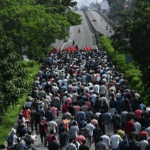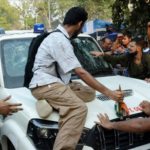Accident serene journey of devotion turned into a nightmare on the Delhi-Mumbai Expressway near Rajasthan’s Dausa district when a bus ferrying devotees collided with two stationary trucks. The incident, attributed to dense fog and poor visibility, left 45 people injured, many of them critically. The horrific crash highlights the pressing need for improved road safety measures, particularly during adverse weather conditions.
This article delves into the tragic details of the accident, examines its causes, and explores the implications for road safety policies in India.
Details of the Accident
The accident occurred early in the morning on the Delhi-Mumbai Expressway, a major highway known for its heavy vehicular movement. The bus, carrying devotees traveling from Ujjain to Delhi, crashed into two stationary trucks, causing significant damage to the vehicle and injuring passengers.
Key Facts:
- Location: Near Dausa, Rajasthan, on the Delhi-Mumbai Expressway.
- Time: Around 4:30 AM, during peak fog hours.
- Casualties: 45 injured, including women, children, and elderly passengers.
- Condition of Victims: Several passengers sustained serious injuries, with some requiring emergency surgery.
DSP Charul Gupta, investigating the incident, stated that dense fog was the primary factor in the accident. “Poor visibility due to heavy fog and high speed led to this unfortunate incident,” she said.  For the more information click on this link
For the more information click on this link
Chronology of Events
- The Journey Begins: The bus departed from Ujjain the previous evening, carrying over 50 devotees, many of whom were returning from a pilgrimage to the Mahakaleshwar Temple.
- Fog Blankets the Expressway: In the early hours of the morning, dense fog descended on the Delhi-Mumbai Expressway, reducing visibility to a few meters.
- The Collision: Near Dausa, the driver of the bus, likely unable to see clearly, failed to notice two trucks parked on the roadside. Despite attempts to swerve, the bus rammed into the vehicles, leading to a pileup and chaos.
- Emergency Response: Local residents and authorities rushed to the scene, working through the fog to rescue trapped passengers. Ambulances transported the injured to nearby hospitals, including Dausa District Hospital and Jaipur’s SMS Hospital.
Survivor Testimonies
Passengers onboard the bus recounted harrowing details of the crash, describing a scene of confusion and distress.
- A Devotee’s Account: “We were all asleep when a loud noise woke us up. The impact threw passengers out of their seats. It was chaos everywhere,” said Manoj Sharma, a survivor.
- A Mother’s Trauma: One woman, traveling with her children, recalled the desperate cries for help and the terrifying moments trapped inside the mangled bus.
Causes of the Accident
While the immediate cause of the crash appears to be the dense fog, a combination of other factors likely contributed:
1. Poor Visibility:
- The dense fog on the expressway significantly reduced visibility, a common occurrence in winter across northern India.
2. Stationary Trucks:
- The trucks involved in the accident were parked on the roadside, possibly without proper warning indicators or reflective signage.
3. Speeding:
- Initial investigations suggest the bus driver was traveling at high speed, unable to stop in time when the trucks came into view.
4. Lack of Adequate Road Safety Measures:
- Insufficient roadside lighting and signage exacerbated the challenges posed by fog and poor weather conditions.
Immediate Aftermath
The collision resulted in a flurry of activity as emergency services, police, and local residents worked tirelessly to rescue victims. Over 15 ambulances were dispatched to the scene, and several passengers were transferred to intensive care units.
Emergency Services:
- Firefighters and local villagers helped extricate passengers trapped in the bus.
- DSP Charul Gupta commended the swift response of the community and emergency teams in minimizing fatalities.
The Delhi-Mumbai Expressway: Promise vs. Challenges
As one of India’s flagship infrastructure projects, the Delhi-Mumbai Expressway was designed to ensure safe and efficient transportation. However, incidents like this raise questions about its readiness to handle emergencies and adverse weather.
Challenges:
- Inadequate Fog Mitigation:
- Winter fog frequently disrupts traffic, yet warning systems and visibility aids remain underdeveloped.
- Rest Stop Management:
- The practice of trucks parking on shoulders due to insufficient rest areas often creates hazards.
- Speed Enforcement:
- The expressway’s smooth roads encourage overspeeding, leading to higher risk during foggy conditions.
Road Safety Measures: What Needs to Be Done
The tragic accident underscores the need for comprehensive road safety measures tailored to India’s unique driving environment.
1. Fog-Specific Strategies:
- Installation of Fog Lights and Sensors: Equipping vehicles with high-intensity fog lights and highways with visibility sensors can help prevent such accidents.
- Fog Warning Systems: Automated systems to alert drivers about reduced visibility zones.
2. Roadside Safety Enhancements:
- Reflective Signage: Ensuring that all stationary vehicles have reflective signs or lights.
- Emergency Lane Policies: Mandating clear lanes for parked vehicles and enforcing stricter fines for improper parking.
3. Driver Training Programs:
- Periodic training and awareness campaigns for commercial drivers on safe driving practices in low visibility.
4. Infrastructure Upgrades:
- Additional lighting, signage, and speed-monitoring cameras along expressways.
Legal and Government Action
In response to the accident, Rajasthan’s Chief Minister, Ashok Gehlot, expressed grief and assured full support to the victims’ families. The state government has ordered an investigation into the incident to determine accountability and evaluate preventive measures.
Compensation:
- Initial announcements include compensation for the injured and financial assistance for families impacted by the crash.
Policy Reform Discussion:
- The accident has reignited discussions on adopting stricter regulations for expressways, including speed limit enforcement and better roadside management.
Similar Past Incidents
Road accidents involving fog are not uncommon in India. The nation witnesses thousands of such incidents annually, particularly during the winter months.
Notable Cases:
- Yamuna Expressway Accident (2021):
- A bus collided with a stationary truck amid dense fog, claiming 12 lives.
- Lucknow-Kanpur Highway Crash (2019):
- A fog-induced pileup involving over 20 vehicles resulted in significant casualties.
These incidents highlight the need for national-level interventions to tackle fog-related road hazards.
Voices from the Community
Local residents and safety advocates have urged authorities to address persistent safety issues on expressways.
- Safety Expert’s Opinion: “High-speed roads need specialized safety systems to counter fog. Without that, such accidents will continue,” said Ravi Tiwari, a highway safety consultant.
- Residents’ Concerns: “This could have been avoided if there were more frequent police patrols and visible road markings,” remarked a local shopkeeper near the accident site.
 For the more information click on this link
For the more information click on this link
Healing and Moving Forward
For the victims of the Dausa accident, the road to recovery is long and painful. Community support, alongside systemic changes, will be essential in restoring confidence among travelers.
Support for Victims:
- Medical Assistance: Local hospitals have rallied to provide immediate and comprehensive treatment for the injured.
- Psychological Support: Counseling services for survivors, especially children and families, can help them cope with trauma.
Conclusion
The tragic collision on the Delhi-Mumbai Expressway serves as a grim reminder of the vulnerabilities in India’s road safety framework, especially under adverse weather conditions. As the nation continues to expand its highway network, ensuring the safety of commuters must remain a top priority.
Stronger regulations, improved infrastructure, and driver awareness are critical to preventing similar tragedies in the future. The incident in Dausa is not just a call for reflection but an urgent plea for action to protect lives on India’s roads. ALSO READ:-Net GST Growth Slows to 3.3% in December: Rising Refunds and Sluggish Revenues





